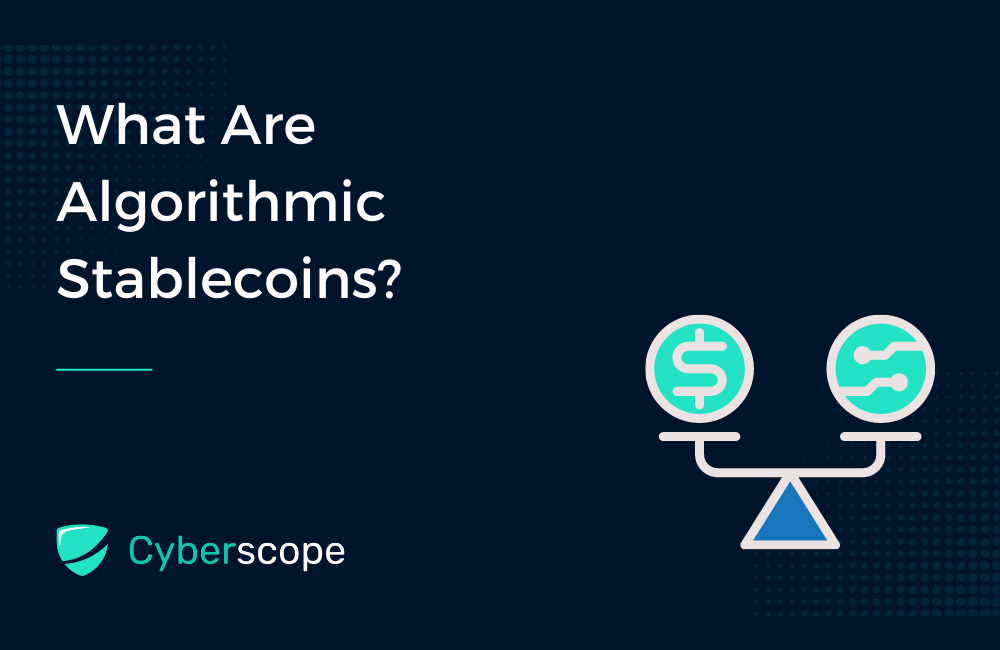

What Are Algorithmic Stablecoins?

After the crash of TerraUSD, the largest algorithmic stablecoin (by market cap) in May 2022, considerable attention was directed at stablecoins, with many investors wondering, “How secure are algorithmic stablecoins?”
Stablecoins were designed to remove some of the volatility from cryptocurrencies. Pegged 1:1 with fiat currencies like the US Dollar, stablecoins are designed to be exactly what they claim to be: price stable. After briefly losing its peg to the dollar, TerraUSD dropped in value from $19 billion to $1 billion, sending the ecosystem spiralling. However, that doesn’t mean that stablecoins are a bad bet for investors.
Before you decide on investing, it’s important to understand how algorithmic stablecoins work, and what makes them different.
How Do Algorithmic Stablecoins Work?

The majority of stablecoins track a currency through a collateralized mechanism and are backed by cash or various other assets. Fiat-backed stablecoins like USDT are backed by fiat currency like the US Dollar. Commodity-backed stablecoins like XAUT are backed by precious metals, oil, or real estate commodities. Crypto-backed stablecoins are backed by crypto, like ETH, and are run by smart contracts.
Algorithmic stablecoins, like Terra’s UST, aren’t backed by fiat, physical assets, or crypto but rather create stability based on specialized algorithms and smart contracts that manage the supply of tokens in circulation and maintain their peg with the fiat currency being tracked. These algorithms can also incentivize investor behaviour to stabilize the coin’s price.
Generally, we refer to rebase and seigniorage algorithmic stablecoins. Rebase stablecoins manipulate the supply of the stablecoin to maintain its peg with fiat currencies by minting and burning coins in line with the price movement of the stablecoin to maintain its valuation. For example, if the stablecoin hits a value below $1, coins will be burnt (removed from circulation) to bring their value up.
Seigniorage stablecoins operate in a similar way but also pair the stablecoin up with other digital currencies and offer incentives to participants to buy or sell the paired cryptocurrencies in order to keep the price of their stablecoin stable. TerraUSD was a seigniorage stablecoin, using its native token (LUNA) to maintain its value against the US dollar.
Here’s what ended up happening. With the protocol, you could exchange $1 of LUNA for 1 UST. When LUNA is swapped for UST, LUNA is burned in order to mint the UST, and vice versa. Unfortunately, when the price of UST drops, participants start swapping for LUNA to earn a profit, which in turn sends the supply of LUNA skyrocketing. Essentially, if your UST falls to $0.5, you can purchase 50 UST for $25, and then swap your 50 UST for $50 of LUNA and sell it to double your profit.
In May 2022, a whale dumped $193 million’s worth of UST, which led to the UST’s value slipping below the dollar. Panic set in, and people started selling LUNA. LUNA’s value dropped from a healthy $87 to $0.00018 in a matter of days.
Are Stablecoins Still a Good Investment?
The collapse of TerraUSD may give most people pause. However, cash-backed stablecoins are still considered solid investments and it’s important not to discount algorithmic stablecoins altogether either.
The dream of a stable and predictive cryptocurrency is still alive. Crypto markets are volatile, and stablecoins offer some assurances that regular cryptocurrencies can’t. The steady value of stablecoins is important for DeFi, especially when it comes to lending, borrowing, and yield farming.

When it comes to algorithmic stablecoins, token supply management (UST and LUNA swapping) caused a death spiral when the peg broke. It’s worth noting that until that ill-fated event, UST only broke the peg twice. Setting parameters and making governance changes could see the algorithmic stablecoin return to favour, mostly because uncollateralized algorithmic stablecoins represent the ultimate holy grail of crypto investing: making money out of nothing. Sure, the failure risks are high, but there will always be investors willing to gamble, and there will always be gambles that pay off.
As cryptocurrencies enter the mainstream financial world, rules and governance will come into play, either self-imposed or mandated by authorities. It’s very likely that participants will demand more robust reserves, even when it comes to algorithmic stablecoins. What that system would look like (and whether it would even be possible) remains to be seen. Some analysts, including Goldman Sachs, have pointed out that algorithmic stablecoins aren’t all different from some currencies on the foreign exchange (like the Hong Kong dollar) that are pegged to others and that additional use cases would create a more stable demand for these crypto-assets.
Conclusion
So, should you buy into an algorithmic stablecoin or not? The answer depends entirely on your risk appetite. Algorithmic stablecoins can offer huge yields and incredible lows, but that’s the case for many cryptocurrencies. If your appetite for risk is low, it’s best to look at some of the upcoming, audited, and reputable stablecoins on the market. You can find them on Coinscope and read their reports to make up your own mind. Algorithmic stablecoins are very likely to remain in play for a long time.

.jpg%3Falt%3Dmedia&w=640&q=75)

